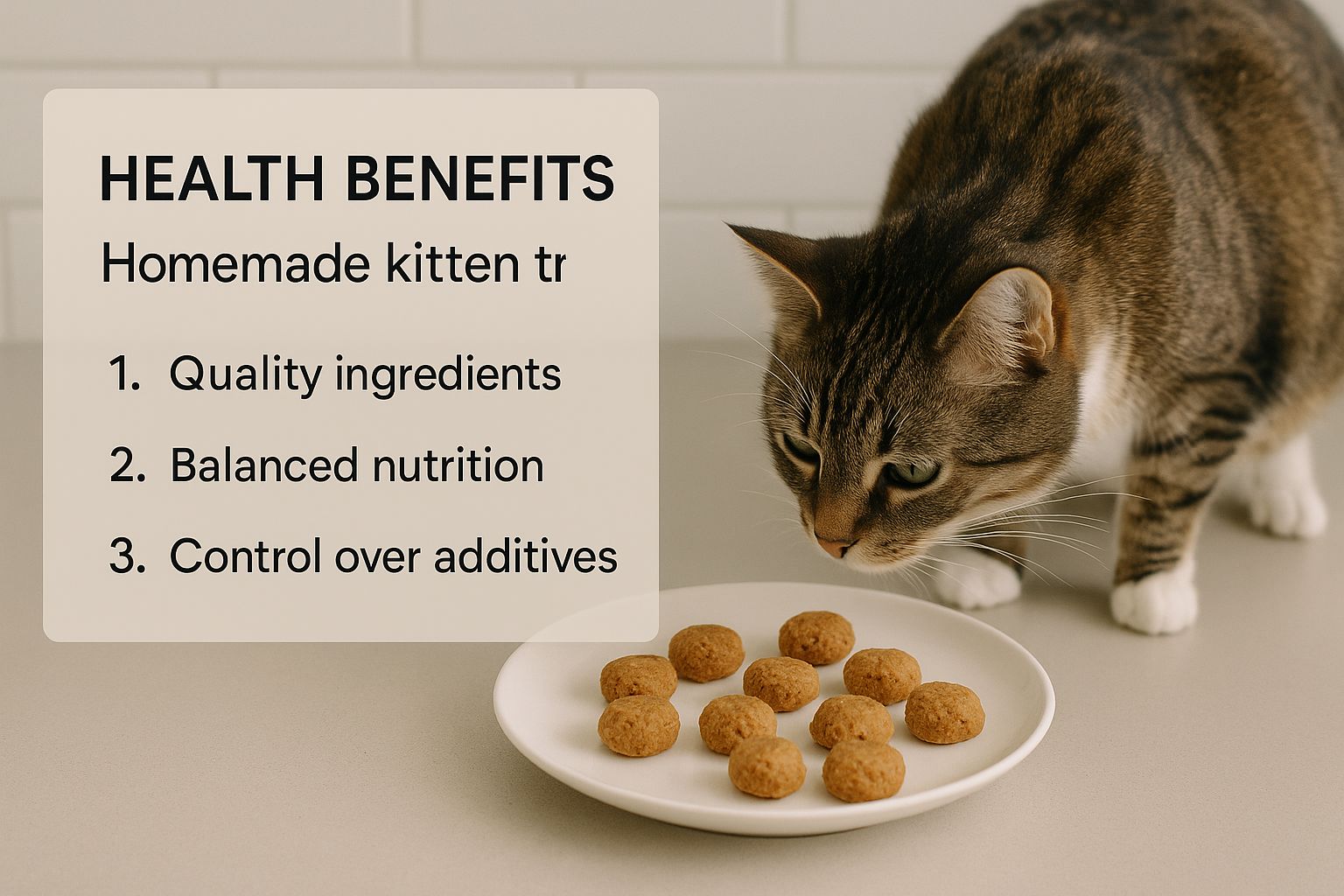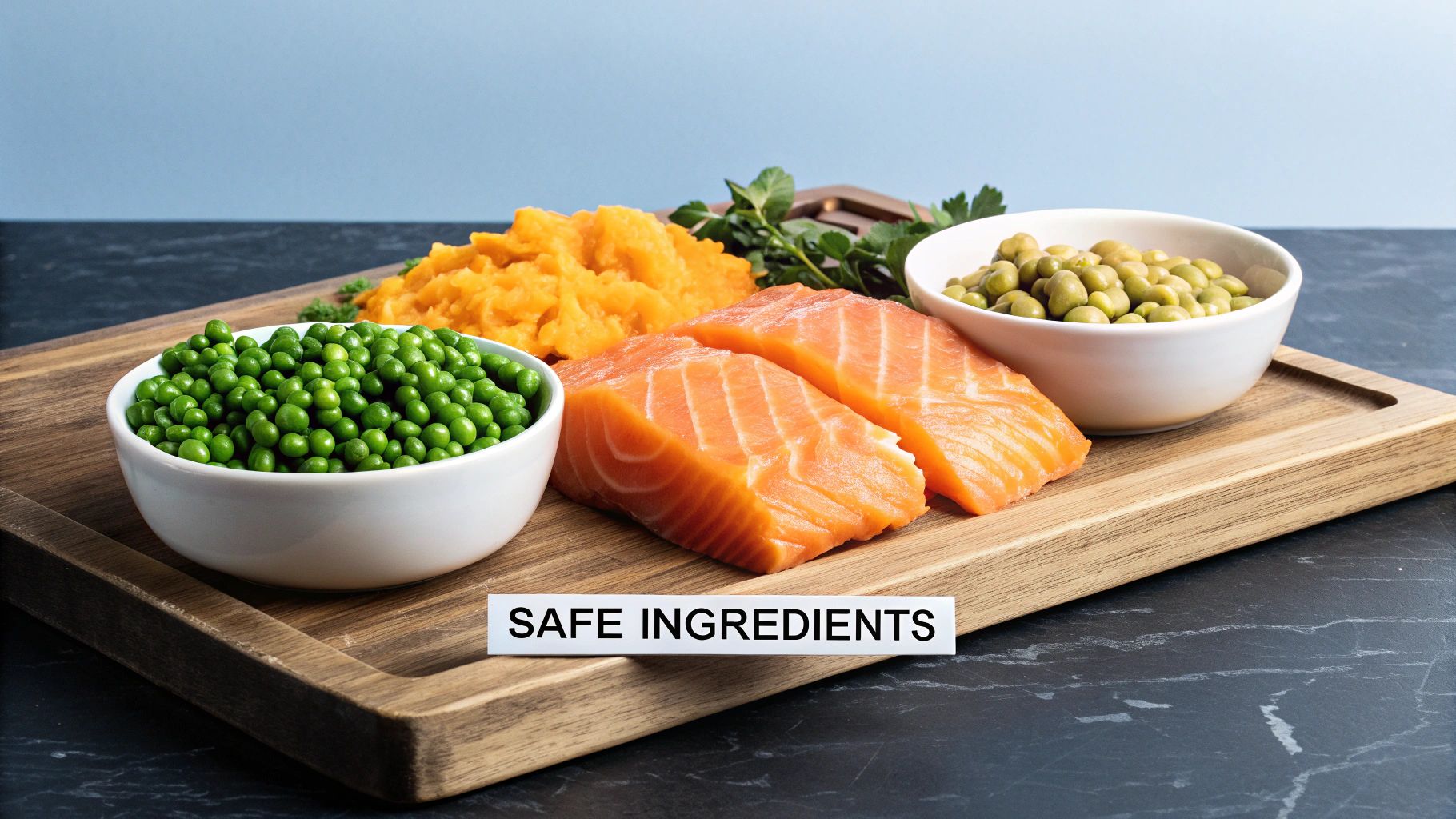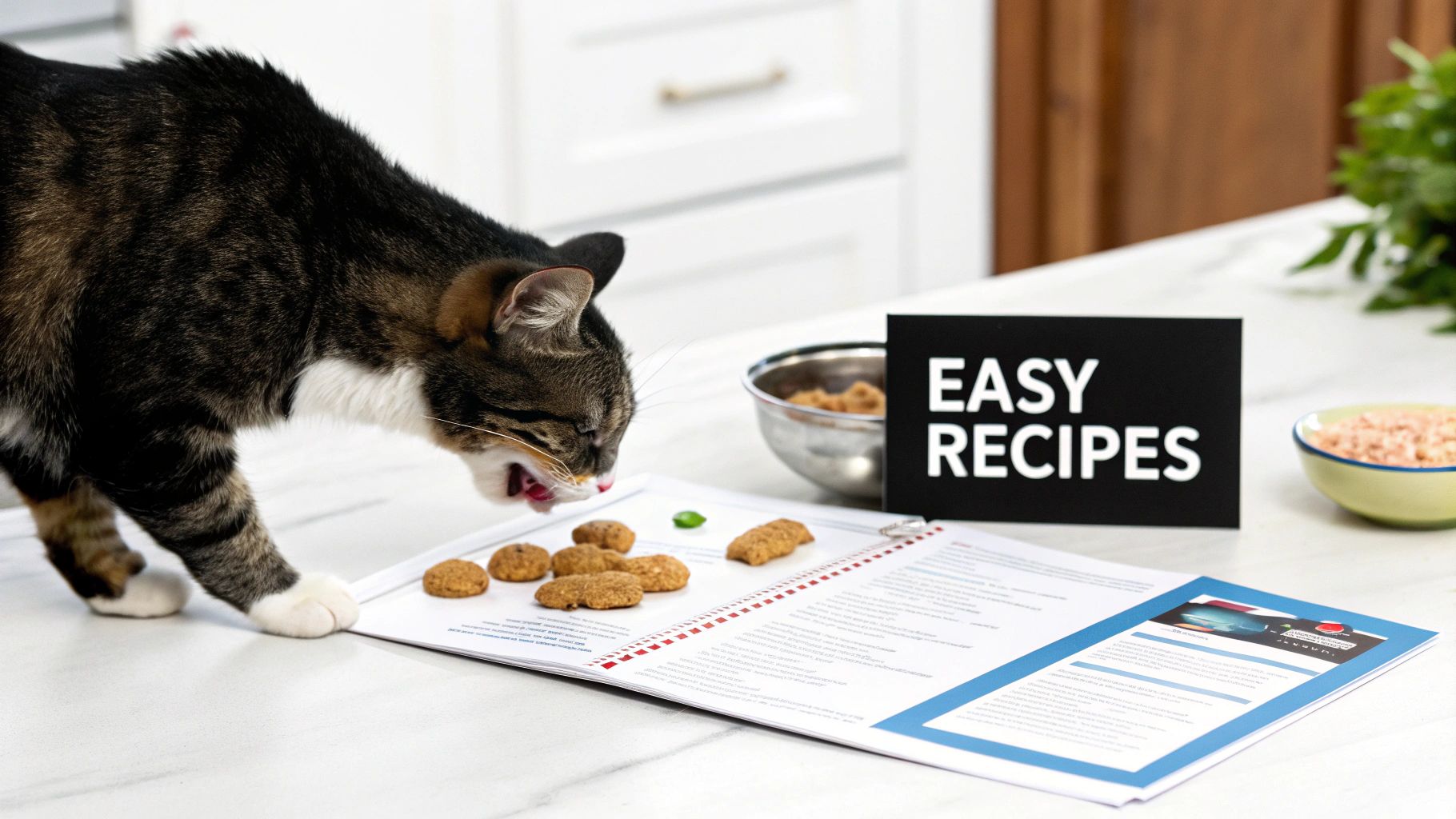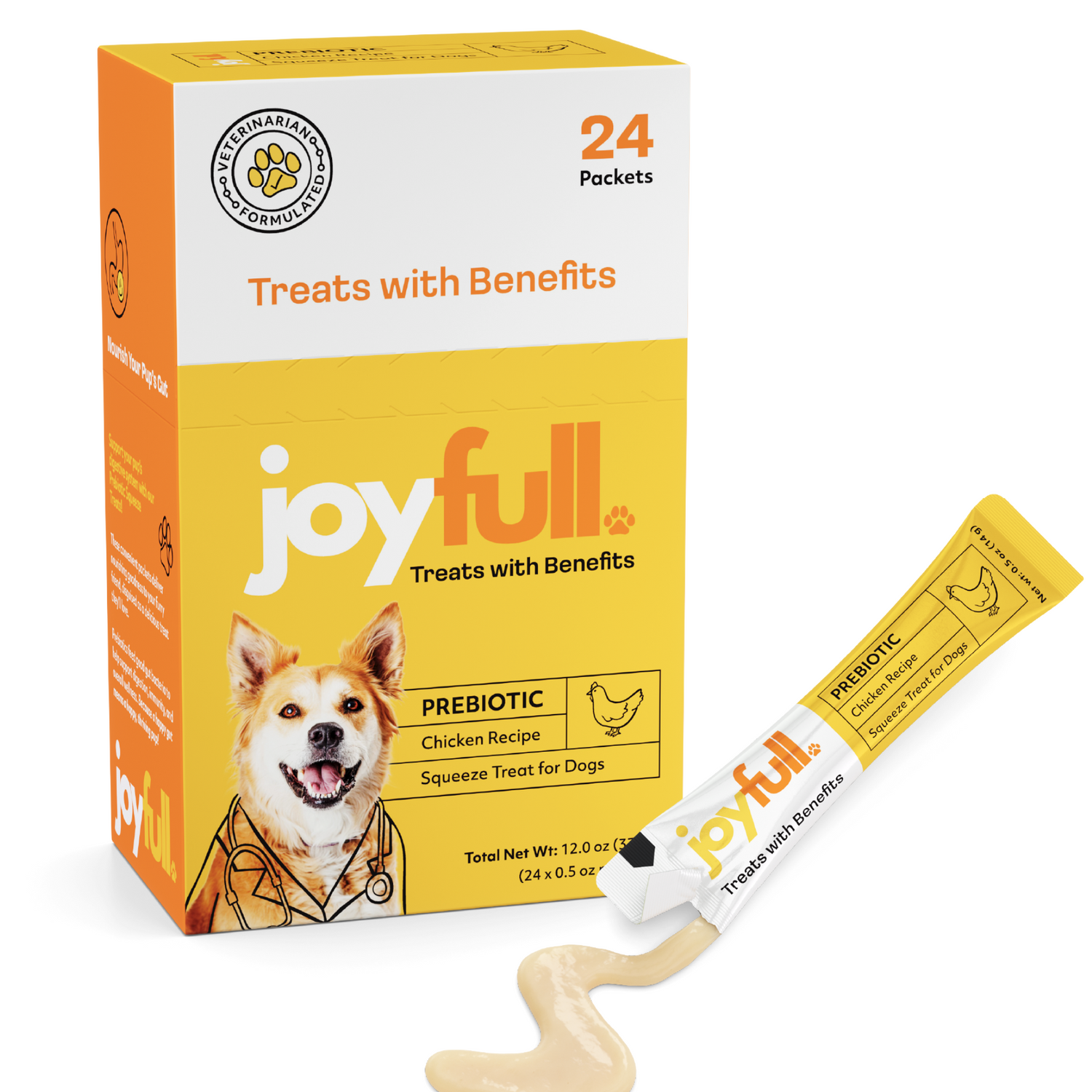
Healthy Treats for Cats Your Feline Will Love
When we talk about "healthy" cat treats, we're not talking about the feline version of junk food. Healthy treats are more like nutrient-packed supplements that complement your cat's daily meals, built from ingredients that respect their natural biology.
The best treats are high in animal protein, low in carbs, and completely free of artificial junk. Think of it as a small, powerful boost to their diet, not just a source of empty calories.
What Makes a Cat Treat Genuinely Healthy
To really get what makes a treat healthy for a cat, you have to understand the cat itself. Cats are obligate carnivores. That’s not just a fancy scientific term—it's the core of their entire being, dictating everything they need to eat to be healthy.
It means their bodies are biologically required—or obligated—to get nutrients from animal sources to survive and thrive.
Imagine your cat's digestive system is a high-performance engine designed specifically to run on animal protein and fat. Carbohydrates—like the corn, wheat, and soy found in so many pet products—are the wrong kind of fuel. It won't cause an immediate breakdown, but over time, it puts a serious strain on the system.
The Foundation of Feline Nutrition
A truly healthy treat honors this fundamental biological blueprint. The ingredient list should be a roll call of high-quality animal proteins, not a lineup of cheap, plant-based fillers.
The absolute essentials for a beneficial treat include:
- High-Quality Animal Protein: This needs to be the #1 ingredient. Look for specific meats like "chicken," "salmon," or "turkey," not vague terms like "meat by-products." Protein is the building block for everything from muscle to energy. You can dive deeper into why this matters in our guide to high-protein cat treats.
- Beneficial Fats: Healthy fats, particularly omega-3 and omega-6 fatty acids from sources like fish oil, are a fantastic source of concentrated energy. They're also what gives your cat that shiny, healthy coat.
- Minimal Carbohydrates: Ideally, a cat’s entire diet should be less than 15% carbohydrates. Unfortunately, many mass-market treats are packed with them, which is a major contributor to feline obesity and digestive upset.
Moving Beyond Basic Nutrition
But the best cat treats don't just stop at the basics. They actually add to your cat's well-being. Some are designed with a crunchy texture to help scrub teeth clean, while others include extra fiber to help manage hairballs.
The real goal is to find treats that act like a mini-meal, delivering a burst of functional nutrition, not just a flavor hit. A great treat enhances a balanced diet; it doesn't take away from it.
At the end of the day, you have to learn to see past the flashy packaging and marketing claims. It all comes back to that one core principle: species-appropriate nutrition. If you prioritize animal protein and ditch the unnecessary fillers, you can be confident that every snack you offer is helping your cat, not hurting them.
How to Decode Cat Treat Ingredient Labels
Walking down the cat treat aisle can feel like navigating a minefield. The packages are bright, the claims are big—"natural," "premium," "gourmet"—but the real truth is always hiding in the tiny print on the back. Learning to read that ingredient list is the single most important skill you can have to make sure you're actually buying healthy treats for your cat.
Think of it like reading a recipe. The ingredients are listed by weight, so whatever comes first is what the treat is mostly made of. For an obligate carnivore like your cat, that means you want to see high-quality, recognizable animal protein right at the top. This isn't just a "nice-to-have"; it's a biological demand.
Green Flags: The Good Stuff to Look For
When you grab a bag of treats, your first glance should be a hunt for the "green flags." These are the ingredients that signal a high-quality product that's actually designed for a cat's body.
Seeing these ingredients at the top of the list is a great sign.
- Named Animal Proteins: You want to see specifics, like "chicken," "turkey," "salmon," or "beef." This transparency tells you the company is using actual muscle meat, which is exactly what your cat’s digestive system is built to handle.
- Animal Organs: Don't be put off by ingredients like "chicken liver" or "beef heart." These are nutritional powerhouses. In the wild, organs are a vital part of a cat's meal, loaded with essential vitamins and minerals you just don't get from muscle meat alone.
- Natural Preservatives: Good treats need to stay fresh, but they don't need harsh chemicals to do it. Look for natural options like tocopherols (a form of Vitamin E) or rosemary extract. They’re safe, effective, and a much better choice.
Red Flags: The Ingredients to Avoid
Knowing what not to look for is just as critical. The "red flags" are typically cheap fillers, mysterious protein sources, and artificial junk that add zero nutritional value. Worse, they can sometimes cause health problems down the road.
A treat's quality isn't just about what it includes; it's also about what it leaves out. A clean, simple ingredient list is often a sign of a superior product focused on nutrition rather than filler.
Here are some of the most common red flags to keep an eye out for:
- Vague Meat Terms: Steer clear of phrases like "meat by-products" or "animal digest." These terms are deliberately vague and can refer to a rendered mix of leftover animal parts that are far less nutritious than whole meat.
- Carbohydrate Fillers: Ingredients like corn, wheat, and soy are just cheap ways to bulk up a treat. Cats have very little biological need for carbohydrates, and a diet packed with them can lead to weight gain and digestive upset.
- Artificial Additives: There is absolutely no reason for artificial colors (like Red 40), fake flavors, or chemical preservatives like BHA, BHT, and ethoxyquin to be in your cat's food. These chemicals are linked to a host of health issues and are completely unnecessary.
This infographic gives you a quick visual rundown of what makes a cat treat truly healthy.

As the graphic shows, choosing treats with pure, simple ingredients is a direct investment in your cat’s well-being. If you want to dive deeper, this comprehensive list of cat food ingredients to avoid is a great resource to help you become an expert label-reader.
To make things even simpler when you're at the store, here's a quick cheat sheet.
Cat Treat Ingredient Cheat Sheet
This handy table is a quick reference guide to help you instantly spot the good stuff and avoid the bad when you're comparing treats.
| Ingredient Type | Green Flag (Look For This) | Red Flag (Avoid This) |
|---|---|---|
| Protein Source | Named meats like 'Chicken' or 'Salmon' | Vague terms like 'Meat By-Products' |
| Preservatives | Natural options like 'Tocopherols' (Vitamin E) | Artificial chemicals like 'BHA' or 'BHT' |
| Fillers | Minimal or no fillers present | High amounts of 'Corn,' 'Wheat,' or 'Soy' |
| Additives | Natural flavor from real meat | Artificial colors, flavors, or sweeteners |
Once you get the hang of spotting these green and red flags, you’ll be able to size up any cat treat on the shelf in seconds. This simple skill turns you from just another shopper into a true advocate for your cat's health, making sure every single snack is one you can feel great about giving.
The Rise of Health-Conscious Feline Snacking

Have you noticed how the cat treat aisle at your local store seems to get bigger and fancier every year? You're not imagining it. Suddenly, we're surrounded by gourmet, natural, and even organic options that simply didn't exist a decade ago. This isn't just a marketing gimmick; it's a reflection of a huge shift in how we think about our cats.
Put simply, we've stopped seeing them as just pets and started treating them like family. This trend, often called "pet humanization," is why so many of us are now scrutinizing ingredient labels on cat treats just as closely as we do for our own snacks.
A New Era of Pet Wellness
This shift has completely changed the game for the pet industry. We're no longer content with tossing our cats a generic, filler-loaded biscuit. We want healthy treats for cats that do more than just taste good—we want them to contribute something positive to their health.
This demand has sent a powerful message to manufacturers, and the market has responded in a big way.
- Ingredient Transparency: Brands are now being pushed to be honest about what's in their products. Vague descriptions are out, and clear, simple ingredient lists are in.
- Focus on Functionality: Many treats are now designed with a purpose. Think dental chews that actually clean teeth, snacks with probiotics for digestive support, or treats with omega fatty acids for a shiny coat.
- Rise of Natural and Organic: The "clean eating" trend has officially crossed over to the pet world. We're seeing more non-GMO, organic, and all-natural treats without artificial junk.
This isn't just a passing fad. It's a fundamental change in how we care for our animals. We see their well-being as a direct extension of our own, and our shopping habits reflect that.
So, if you've been putting a lot of thought into finding the best for your cat, you're not alone. Your search for a truly healthy snack is part of a larger movement to give our feline friends the long, vibrant lives they deserve.
The Market Reflects Our Values
The numbers don't lie. This cultural shift is backed by some serious spending. The global market for pet snacks and treats was recently valued at around $40.7 billion, which is a staggering figure. It's projected to climb to roughly $125.3 billion by 2034, and that growth is fueled almost entirely by our demand for premium, health-focused products. You can dig into the specifics of this trend by checking out the research on pet snack market growth.
So, what does this all mean for you? It's great news. You have more power and better choices than ever before. The market is now catering directly to your desire for high-quality, nutritious options for your cat. Brands are in a race to create cleaner, healthier, and more innovative treats, which makes it much easier to find something that fits your cat's specific needs.
Finding the Perfect Healthy Treat for Your Cat

Alright, you've mastered reading ingredient labels—that's the hard part. Now for the fun part: matching the right treat to your cat's unique personality and health needs. There's no single "best" treat for every cat. Think of it more like a toolkit, where each type of treat has a specific job to do.
Picking the right format can elevate a simple snack into a truly beneficial part of your cat’s day. Whether you're dealing with a senior cat's sensitive gums or a rambunctious kitten who needs a little training motivation, the perfect treat is out there.
Crunchy Treats for Dental Health
Let's start with the classic. Crunchy treats are probably what you see most on store shelves, and for good reason. They serve two purposes at once. As your cat chomps down, that abrasive texture helps scrub away plaque and tartar buildup, giving their teeth a little extra help between vet cleanings.
These are a fantastic go-to for most adult cats, particularly if they're prone to dental issues. Just remember, the same rules apply here: flip that bag over and make sure a high-quality animal protein is the first thing you see, not a cheap grain filler.
Soft Chews for Sensitive Mouths
For our older feline friends, kittens with their baby teeth, or any cat with dental sensitivities, soft chews are a godsend. They deliver all the flavor and nutrition of a great treat without asking for any tough chewing.
Here's another great use for them: hiding medication. A soft, pliable treat makes it incredibly easy to wrap a pill, turning what can be a stressful daily chore into a positive moment for both of you. When you're shopping, look for chews that are moist but not greasy, with a nice, short ingredient list.
The fact that we even have so many specialized options shows how much the pet industry is changing. The global cat food market is on track to hit $24.87 billion by 2025, and it's driven by people like us who want better, more tailored nutrition for our pets. You can learn more about this expanding market and what it means for cat owners from market research.
Lickable Purées for Hydration and Bonding
You've probably seen these lickable treats in tubes or pouches—they've become a huge hit, and it's easy to see why. These purées are a phenomenal way to sneak extra moisture into your cat's diet. Since so many cats are poor drinkers, this is a major win for their health.
They're also amazing for a few other things:
- Bonding: There's something really special about hand-feeding your cat from a tube. It's an intimate moment that really strengthens your connection.
- Food Toppers: Got a picky eater? A little squeeze of a tasty purée over their regular food can be just the thing to get them interested.
- Low-Calorie Snacking: They tend to be lower in calories than solid treats, making them a great option for light snacking.
Freeze-Dried Treats for the Purist
If you're an ingredient purist, freeze-dried treats are your holy grail. These are as simple as it gets—often just a single ingredient like 100% chicken breast, salmon, or beef liver. Nothing else added.
The freeze-drying process is brilliant; it removes all the water but locks in nearly all the nutrients and intense, natural flavor of the raw meat. This makes them a powerfully nutritious and species-appropriate snack for any cat. It's like getting all the benefits of a raw diet without the hassle or safety worries.
Functional Treats for Targeted Support
Finally, there’s a whole category of treats designed to do more than just taste good: functional treats. These are formulated with active ingredients to help with specific health issues.
You'll commonly find treats for:
- Hairball Control: These have extra fiber to help things move smoothly through the digestive system.
- Joint Support: Usually contain glucosamine and chondroitin to support mobility in older cats.
- Calming Treats: Formulated with gentle ingredients like L-theanine or chamomile for anxious cats.
- Skin & Coat Health: Boosted with omega-3 and omega-6 fatty acids for a healthy, shiny coat.
By thinking about what your cat really needs—whether it's better dental health, more hydration, or support for their joints—you can choose a treat that becomes a valuable part of their overall wellness plan.
Simple and Safe Homemade Cat Treat Recipes
There’s something incredibly rewarding about making your cat’s treats from scratch. When you’re in control of the kitchen, you have complete say over what goes into their food. No more squinting at ingredient labels wondering about weird fillers or preservatives—just simple, wholesome, cat-safe goodness.
This isn’t just a niche hobby, either. Cat owners everywhere are demanding better for their pets. We've seen a huge 9.5% jump in cat treat sales recently, a bigger leap than in any other pet food category.
Think about it: out of the nearly $14.7 billion Americans spent on cat food in a single year, treats made up a whopping $1.88 billion, or 12.8% of the total pie. It’s clear that high-quality snacks are no longer an afterthought.
Kitchen Pantry Do's and Don'ts
Before you start whipping up a feline feast, it’s absolutely critical to know what's safe and what’s not. A simple slip-up with a common kitchen ingredient can have serious consequences for your cat, so always check your list twice.
Safe Foods for Feline Treats:
- Cooked Meats: Plain, unseasoned chicken, turkey, or lean beef are always a hit and packed with protein.
- Cooked Fish: Salmon and tuna are fantastic for their omega-3 fatty acids, but keep them as an occasional treat, not a daily staple.
- Pumpkin Purée: Make sure it's 100% pure pumpkin, not pie filling. It works wonders for digestion.
- Cooked Eggs: A scrambled or boiled egg is a protein powerhouse your cat will love.
Toxic Foods to ALWAYS Avoid:
- Onions, Garlic, and Chives: These are all in the allium family and can destroy a cat's red blood cells, leading to anemia.
- Chocolate and Caffeine: These are major toxins for cats, affecting their heart and nervous system.
- Grapes and Raisins: These can cause sudden kidney failure.
- Xylitol: This artificial sweetener is extremely dangerous, even in tiny amounts.
Safety starts from the very beginning, so always be mindful of things like safe thawing practices for ingredients like chicken.
Two-Ingredient Tuna Bites
You can't get much easier than this. This recipe is a home run with even the fussiest felines, and it only takes two ingredients you probably already have.
- Prepare Your Ingredients: Grab one 5-ounce can of tuna in water (no salt added, please!) and drain it really well. You'll also need one large egg.
- Combine and Form: In a small bowl, use a fork to flake the tuna until it's fine. Crack in the egg and mix it all together until you have a thick, dough-like paste.
- Bake: Heat your oven to 350°F (175°C). Drop tiny, pea-sized dollops of the mixture onto a baking sheet lined with parchment paper.
- Cool and Store: Bake for 10-12 minutes until the little bites are firm and just turning golden. Let them cool completely before you offer one to your eager assistant.
You can store these in an airtight container in the fridge for up to five days. If you're looking for more fun recipes, check out our full guide to delicious homemade healthy cat treats.
Savory Chicken and Pumpkin Purée
This one is for the cats who prefer a softer, lickable treat. It’s also a fantastic food topper to entice a picky eater and adds a nice little hydration boost.
Pro Tip: Pour this purée into an ice cube tray and freeze it. You'll have ready-to-go "catsicles" that make for a refreshing and enriching treat on a warm day.
Instructions:
- In a blender or food processor, combine 1/2 cup of plain, cooked, and shredded chicken with 2 tablespoons of plain pumpkin purée.
- Add 1-2 tablespoons of water or low-sodium chicken broth to get things moving.
- Blend until the mixture is completely smooth.
- Serve a small spoonful directly to your cat or mix it into their regular meal.
This purée will keep in the fridge for about three days. By making your own treats, you're not just saving a little money—you're giving your cat the freshest, healthiest snacks possible.
How to Give Treats Without Spoiling Your Cat (or Their Dinner)
It’s easy to go overboard with treats. After all, who can resist that hopeful little face and rumbling purr? But even the healthiest, most protein-rich snack can cause problems if you're a little too generous. Finding a good treat is only the first step—the real trick is learning how to give them out responsibly.
Think of treats like dessert. For us, a little bit of something special is a wonderful thing, but it's not meant to replace a well-rounded meal. It's the same for our cats.
Giving too many treats is one of the most common pitfalls for loving cat owners. It’s an easy habit to fall into, but it can quietly pave the way for some serious health issues down the road. The biggest concerns are weight gain and nutritional imbalance. Feline obesity is a massive problem, linked to a higher risk of diabetes, arthritis, and even a shorter lifespan.
The Vet’s Secret Weapon: The 10 Percent Rule
So, how do you keep it all in check? Feline nutritionists and vets have a simple guideline that works wonders: the 10 percent rule. It’s your best friend when it comes to responsible treating.
The rule is simple: treats should never make up more than 10% of your cat’s total daily calories. The other 90% needs to come from their complete and balanced cat food.
This keeps treats in their proper place—as a fun bonus, not a dietary staple. Following this rule ensures your cat gets all the essential nutrients from their main meals while preventing them from packing on extra pounds from too many snacks.
Putting this into practice is straightforward. First, figure out your cat's daily calorie needs. This will change based on their age, weight, and how much they zoom around the house, but a typical indoor adult cat needs about 200-250 calories per day. You can find the calorie count on your cat's food and treat bags.
For example, if your cat eats 200 calories a day, their treat allowance is just 20 calories. That’s it for the whole day!
Make Treat Time More Than Just a Snack
Once you know your calorie budget, you can get creative. The goal is to make treats a positive experience that strengthens your bond and stimulates your cat's mind, not just a handout.
Here are a few ways to make every treat count:
- Make Them Work for It: Pop treats into a puzzle toy instead of just handing them over. This taps into their natural hunting instincts and gives their brain a little workout.
- Reward Good Habits: Use small, delicious treats as a reward during training. This is perfect for reinforcing positive behaviors, like using the scratching post instead of your favorite armchair.
- Break It Up: You can often break a single treat into several tiny pieces. Your cat gets the satisfaction of multiple rewards, but you’re still staying within your calorie limit.
By sticking to the 10 percent rule and turning treat time into an enriching activity, you can be sure you're giving your cat a little extra love in the healthiest way possible.
Your Top Questions About Healthy Cat Treats, Answered
When it comes to our cats' nutrition, it’s only natural to have a few questions. Even after you've learned the basics of good ingredients, real-world situations can pop up that leave you scratching your head. Let's clear up some of the most common concerns.
This is your quick guide for those "what if" moments. We'll cut through the confusion and tackle some common myths so you can feel totally confident about the treats you're choosing for your feline friend.
Can I Give My Cat Dog Treats?
It's a classic scenario: you run out of cat treats, but the dog's treat jar is full. While one accidental nibble probably won't hurt, you should never make it a habit. Cats and dogs have completely different nutritional blueprints.
Cats are obligate carnivores. This means their bodies are built to run on animal protein and require specific nutrients, like taurine, that are vital for their heart and eye health. Dog treats are often loaded with carbohydrates and plant-based fillers that a cat's digestive system simply isn't designed to handle. Always stick to treats made specifically for cats—it's the safest and healthiest way to go.
Are Grain-Free Treats Always Better for Cats?
"Grain-free" has become a massive buzzword in the pet food aisle, but it's not an automatic stamp of quality. It’s true that a wild cat’s diet is naturally free of grains, but what really matters is what those grains are replaced with. Some brands simply swap out corn or wheat for other high-carb fillers like potatoes and peas.
The most important factor in any healthy treat for cats is not the absence of grain, but the presence of high-quality, named animal protein as the number one ingredient.
For a cat with a diagnosed grain allergy, going grain-free is a must. For everyone else, a treat that's high in protein and low in all carbs (whether from grains or not) is a fantastic choice.
How Can I Tell If My Cat Is Allergic to a New Treat?
It's always smart to play it safe when introducing something new. Food allergies and sensitivities can show up in a few different ways. Start small—give your cat just a tiny piece of the new treat and keep a close eye on them for the next 24 to 48 hours.
Watch for any of these tell-tale signs:
- Tummy Troubles: This is the most common one. Look for vomiting or diarrhea.
- Itchy Skin: Is your cat suddenly scratching more than usual? Red skin, bald patches, or scabs can point to an allergic reaction.
- Breathing Changes: While less common, things like coughing or wheezing after trying a new food could also be a red flag.
If you spot any of these symptoms, stop giving the treat right away and give your vet a call. A good rule of thumb is to introduce only one new food at a time. That way, if a problem does pop up, you know exactly what caused it.
At JoyFull, we believe that a healthful life isn’t just for humans. Our pets deserve it, too. That’s why we create treats with clean ingredients and high-quality proteins, all backed by veterinary expertise. Discover the difference that genuinely beneficial snacks can make for your cat. Learn more at https://joyfullpet.com.

